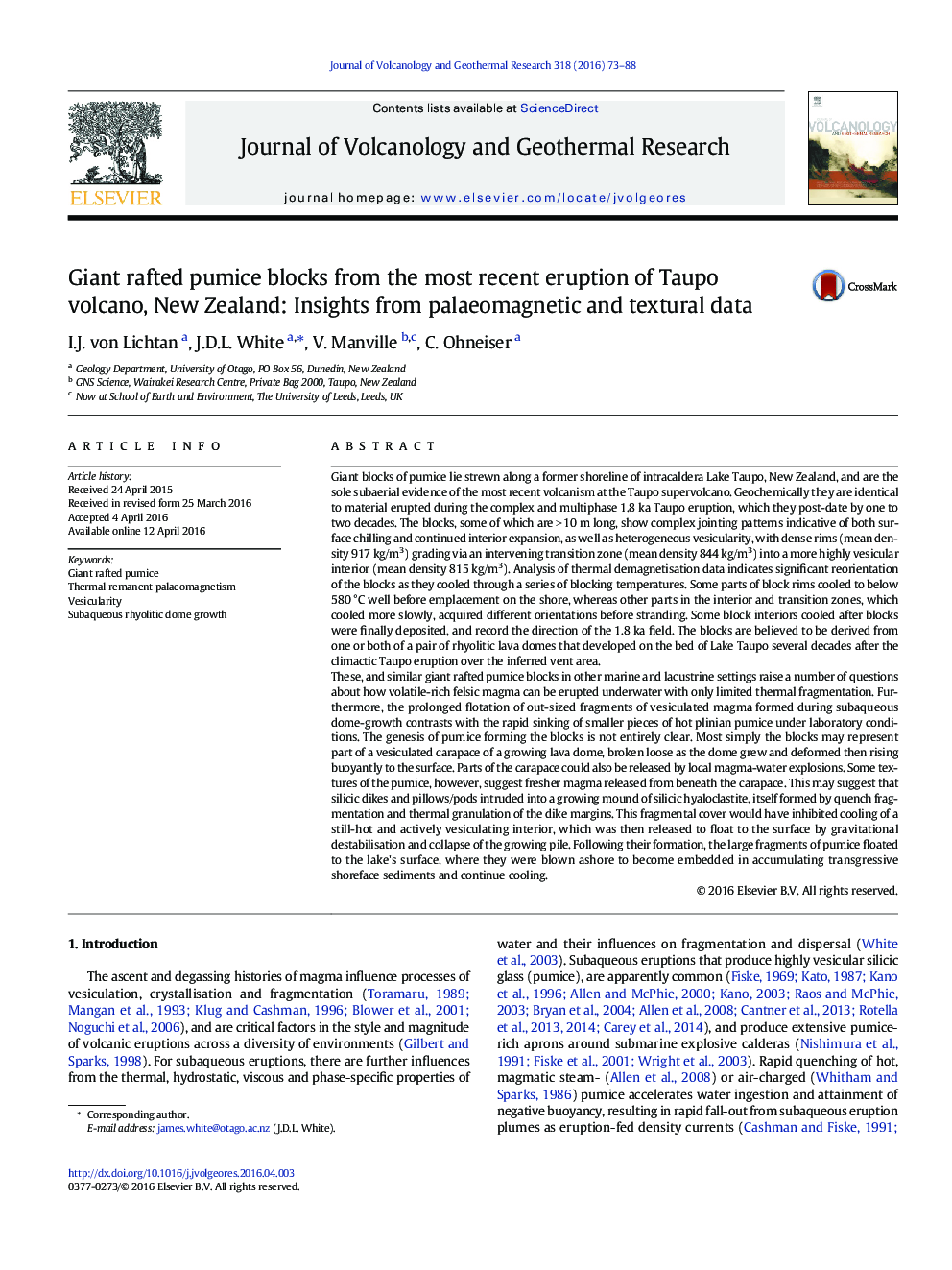| کد مقاله | کد نشریه | سال انتشار | مقاله انگلیسی | نسخه تمام متن |
|---|---|---|---|---|
| 4712702 | 1638304 | 2016 | 16 صفحه PDF | دانلود رایگان |
• Giant pumice blocks were erupted from a sublacustrine dome in Lake Taupo and floated to shore.
• Pumice textural features are characterised, and pumice block locations/elevations mapped.
• Paleomagnetic analysis shows that blocks rotated after initial cooling, then lodged at shoreline before fully cooled.
Giant blocks of pumice lie strewn along a former shoreline of intracaldera Lake Taupo, New Zealand, and are the sole subaerial evidence of the most recent volcanism at the Taupo supervolcano. Geochemically they are identical to material erupted during the complex and multiphase 1.8 ka Taupo eruption, which they post-date by one to two decades. The blocks, some of which are > 10 m long, show complex jointing patterns indicative of both surface chilling and continued interior expansion, as well as heterogeneous vesicularity, with dense rims (mean density 917 kg/m3) grading via an intervening transition zone (mean density 844 kg/m3) into a more highly vesicular interior (mean density 815 kg/m3). Analysis of thermal demagnetisation data indicates significant reorientation of the blocks as they cooled through a series of blocking temperatures. Some parts of block rims cooled to below 580 °C well before emplacement on the shore, whereas other parts in the interior and transition zones, which cooled more slowly, acquired different orientations before stranding. Some block interiors cooled after blocks were finally deposited, and record the direction of the 1.8 ka field. The blocks are believed to be derived from one or both of a pair of rhyolitic lava domes that developed on the bed of Lake Taupo several decades after the climactic Taupo eruption over the inferred vent area.These, and similar giant rafted pumice blocks in other marine and lacustrine settings raise a number of questions about how volatile-rich felsic magma can be erupted underwater with only limited thermal fragmentation. Furthermore, the prolonged flotation of out-sized fragments of vesiculated magma formed during subaqueous dome-growth contrasts with the rapid sinking of smaller pieces of hot plinian pumice under laboratory conditions. The genesis of pumice forming the blocks is not entirely clear. Most simply the blocks may represent part of a vesiculated carapace of a growing lava dome, broken loose as the dome grew and deformed then rising buoyantly to the surface. Parts of the carapace could also be released by local magma-water explosions. Some textures of the pumice, however, suggest fresher magma released from beneath the carapace. This may suggest that silicic dikes and pillows/pods intruded into a growing mound of silicic hyaloclastite, itself formed by quench fragmentation and thermal granulation of the dike margins. This fragmental cover would have inhibited cooling of a still-hot and actively vesiculating interior, which was then released to float to the surface by gravitational destabilisation and collapse of the growing pile. Following their formation, the large fragments of pumice floated to the lake's surface, where they were blown ashore to become embedded in accumulating transgressive shoreface sediments and continue cooling.
Journal: Journal of Volcanology and Geothermal Research - Volume 318, 15 May 2016, Pages 73–88
